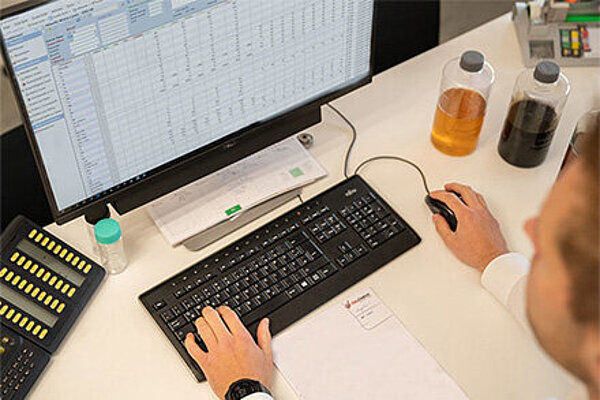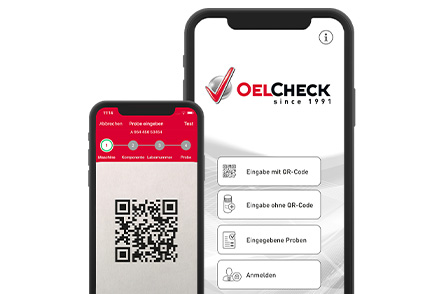Limit values at OELCHECK
Publication year: 2023
OELCHECK uses limit values when evaluating lubricant and fuel analyses.
Where do these values actually come from? And how do you apply them when examining of up to 2,000 samples every day?
When examining lubricant and fuel samples, we usually determine 35 to 50 different individual values. However, we cannot evaluate the samples on the basis of these figures alone. Even the most experienced tribologist needs limit values in order to evaluate the results of an analysis and make recommendations. More than 200,000 machine-specific limit value tables are therefore stored in the large OELCHECK database. These are increasing all the time, because as soon as a sample for a new lubricated machine component or a new lubricant arrives in our laboratory, for example, we create another data master. All information is recorded digitally in the large OELCHECK database and prepared with the help of the company's own software programs. After all, we need to be able to enter, adjust and ultimately use the limit values when evaluating samples in a clear and quick manner.

OELCHECK uses tailored limit values
A variety of limit values are required when assessing a wide range of parameters in a laboratory report. Whether it's impurities such as water or dust, the content of wear metals or the general oil condition such as viscosity or oxidation, nothing is possible without limit values.
Existing limit values can come from different sources, including:
- Standardisation bodies such as DIN or ASTM (American Society for Testing Material)
- OEMs of machines and components
- Manufacturers of lubricants and fuels
However, these values are usually defined according to general criteria or they only take into account some of the values analysed in a lubricant sample. Yet, a precise diagnosis can only be obtained through a holistic and individual examination of each particular case.
OELCHECK therefore uses the company’s own machine-specific limit value tables. Although these take into account the specifications of the OEMs and other sources, they also take into account the results of over five million lubricant and fuel samples that we have examined in our laboratory to date. This is supplemented by our expertise and the extensive experience we have thanks to our close exchange with countless customers. Usually, the limit values are defined based on our database and experience, but also with the input of our customers and feedback from the field.
Our tailored limit values do not generalise, but rather:
- take into account the respective applications and their wide range of requirements
- consider the individual load level of the components
- include the various environmental conditions
- also incorporate the different requirements and questions of customers when evaluating the analyses
However, evaluating a sample on the basis of limit values alone can also be misleading! Therefore, we do not publish any limit values in our laboratory reports. It is simply not enough to look at individual values; they must always be seen in context.
This also includes taking into account information such as the fill quantity and service life of a lubricant or fuel as well as the trend of its development. Preparing a diagnosis is therefore often multi-layered and complex, which is why it should generally only be left to an experienced tribologist.
Limit values in use at OELCHECK
When an OELCHECK tribologist starts assessing an analysis, they receive all available information from the company's own evaluation software. These include the current analysis values as well as any previous trend samples, the corresponding limit values, the reference values of the fresh product, various diagrams such as the FTIR spectrum, photos of the sample bottle, all available information on the component or machine and on the lubricant or fuel.
The limit values provide initial guidance for the tribologist. If limit values are undershot or exceeded, a corresponding comment is made by the tribologist. However, it is not sufficient to evaluate the affected parameters individually; this should always take place in the context of other analysis values in order to identify the cause or further effects.
For example, excessive water content may already represent a valuable piece of information for the customer. Nonetheless, it is also often possible to draw conclusions from other analysis values as to whether it concerns condensation or water ingress due to a leak in the cooling circuit. This allows the customer to receive a corresponding recommendation for action.
Or looking at the example of viscosity: When it comes to an engine oil, the tribologist can use their knowledge and data to assess whether increased viscosity has been caused by oil oxidation, nitration, soot entry or a coolant leak. In the case of wear element values, for example, additional trend curves are often very helpful. How have the values developed over time? Are there currently any alarming outliers?
How you can support us...
Ultimately, the tribologist must always decide whether a situation is critical and what the recommendation to the customer should be.
However, even in the age of digitalisation, we depend on the completeness and quality of the information provided with an analysis. Although samples can be evaluated along many points even with little information, the same principle applies as when visiting the doctor: the more information provided for the investigation, the more accurately the analysis data can be interpreted. And this is where our customers' duty lies. Therefore, in your own interest, please fill out our sample information forms carefully. The quickest and most convenient way to complete and transfer the sample information forms is electronically via the OELCHECK APP 4.0, with or without the use of QR codes, via the OELCHECK customer portal or via data import using an API. The key data concerning the lubricant and the machine is entered once during electronic data transfer and is then always available. You simply add the variable data of the current oil sample (e.g. oil level time) and can also inform us of any anomalies.

OELCHECKER Winter 2023, page 7




